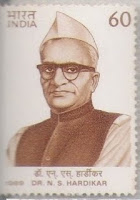We have seen in the last post dated June 8, 2010 that All India Congress Committee rejected the All Saffron Flag as recommended by the Flag Committee(1931), and instead approved a new Tricolour Flag popularly known Purna Swaraj Flag in India.
The new Purna Swaraj Flag immediately acquired irresistible power, it betokened fearlessness and faith amongst the Freedom fighters in their ultimate victory in gaining Independence in 1947.
The Patriotic cover shows the effigy of Mahatma Gandhi flanked by the new Tricolour flags and the legend ‘Vande Mataram’ in Tamil.The envelope is chopped with Japanese censored mark and was postally carried in Malaya then under Japanese occupation during World War II (Postage stamps were duly affixed at the back)
“Kumaran's Hand Holding the Flag” Postmark from Tirupur issued on August 15, 1997 commemorating the 50th. Anniversary. of Independence
Kodi Kaatha Kumaran (1904 - 1932)
Kumaran - The protector of the Flag, on January 10, 1932, Kodi Kaatha Kumaran, a brave young mill-hand of Tirupur, Madras (now Tamil Nadu) was leading a labour resistance procession holding the tricolour in his hand, when police attacked Kumaran brutally he exhibited an exemplary act of defiance against the British violence by holding the Tricolour up while raising the freedom cry ‘Vande Matarm’. Kumaran succumbed to his injuries next day. Sanjiva Nijalingappa actively participated and courted arrest in the 'Flag Satyagraha' organised by the Mysore Congress in April 1938 at Shivapura near Maddur, Karnataka.
On August 8, 1942 Mahatma Gandhi gave the historic call “Quit India” in Bombay and raised the slogan “Do or Die” for the cause.
On August 9, following the arrest of most of the prominent leaders, Aruna Asaf Ali came forward and hoisted the National Flag at Gowalia Tank Maidan (Renamed, August Kranti Maidan) in Bombay (now Mumbai).
Matangini Hazra was an active participant of the Quit India Movement at the age of 73. On 29th. Sept, 1942 while she was leading a procession in Tamluk, Bengal and advanced with the Tricolour flag in her hands, a shower of bullets from the police felled her, but the flag was still flying in her hands unsullied.
The August Kranti at Ballia,under the leadership of Chittu Pandey was an inspiring chapter of the “Quit India” Movement
The bronze sculpture (by D. P. Roychoudhury) depicts the seven students who lost their lives while attempting to hoist the flag atop old Patna Secretariat building during Quit India Movement. The seven students, who's names are engraved on Martyrs’ Memorial, Patna.;* Umakant Prasad Sinha - Ram Mohan Roy Seminary, class IX * Ramanand Singh - Ram Mohan Roy Seminary, class IX * Satish Prasad Jha - Patna Collegiate School, class X * Jalpati Kumar - Bihar National College, 2nd year * Devipada Choudhry - Miller High English School, class IX * Rajendra Singh - Patna High English School, matric class * Ramgovind Singh - Punpun High English School, matric class.
(To be continued)

































































